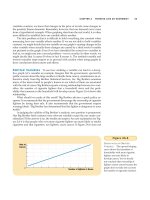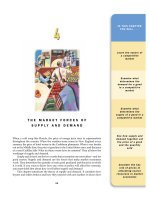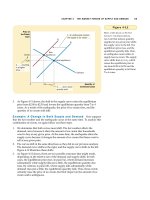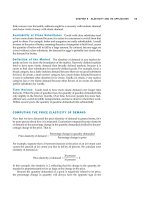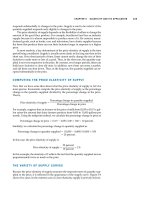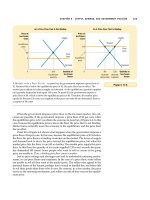Tài liệu Ten Principles of Economics - Part 63 pdf
Bạn đang xem bản rút gọn của tài liệu. Xem và tải ngay bản đầy đủ của tài liệu tại đây (237.13 KB, 10 trang )
CHAPTER 28 MONEY GROWTH AND INFLATION 641
QUICK QUIZ: The government of a country increases the growth rate
of the money supply from 5 percent per year to 50 percent per year. What
happens to prices? What happens to nominal interest rates? Why might the
government be doing this?
THE COSTS OF INFLATION
In the late 1970s, when the U.S. inflation rate reached about 10 percent per year, in-
flation dominated debates over economic policy. And even though inflation was
low during the 1990s, inflation remained a closely watched macroeconomic vari-
able. One 1996 study found that inflation was the economic term mentioned most
often in U.S. newspapers (far ahead of second-place finisher unemployment and
third-place finisher productivity).
Inflation is closely watched and widely discussed because it is thought to be a
serious economic problem. But is that true? And if so, why?
A FALL IN PURCHASING POWER? THE INFLATION FALLACY
If you ask the typical person why inflation is bad, he will tell you that the answer
is obvious: Inflation robs him of the purchasing power of his hard-earned dollars.
When prices rise, each dollar of income buys fewer goods and services. Thus, it
might seem that inflation directly lowers living standards.
Yet further thought reveals a fallacy in this answer. When prices rise, buyers of
goods and services pay more for what they buy. At the same time, however, sellers
of goods and services get more for what they sell. Because most people earn their
incomes by selling their services, such as their labor, inflation in incomes goes
hand in hand with inflation in prices. Thus, inflation does not in itself reduce people’s
real purchasing power.
People believe the inflation fallacy because they do not appreciate the princi-
ple of monetary neutrality. A worker who receives an annual raise of 10 percent
tends to view that raise as a reward for her own talent and effort. When an infla-
tion rate of 6 percent reduces the real value of that raise to only 4 percent, the
worker might feel that she has been cheated of what is rightfully her due. In fact,
as we discussed in Chapter 24, real incomes are determined by real variables, such
as physical capital, human capital, natural resources, and the available production
technology. Nominal incomes are determined by those factors and the overall
price level. If the Fed were to lower the inflation rate from 6 percent to zero, our
worker’s annual raise would fall from 10 percent to 4 percent. She might feel less
robbed by inflation, but her real income would not rise more quickly.
If nominal incomes tend to keep pace with rising prices, why then is inflation
a problem? It turns out that there is no single answer to this question. Instead,
economists have identified several costs of inflation. Each of these costs shows
some way in which persistent growth in the money supply does, in fact, have
some effect on real variables.
642 PART TEN MONEY AND PRICES IN THE LONG RUN
SHOELEATHER COSTS
As we have discussed, inflation is like a tax on the holders of money. The tax itself
is not a cost to society: It is only a transfer of resources from households to the gov-
ernment. Yet, as we first saw in Chapter 8, most taxes give people an incentive to
alter their behavior to avoid paying the tax, and this distortion of incentives causes
deadweight losses for society as a whole. Like other taxes, the inflation tax also
causes deadweight losses because people waste scarce resources trying to avoid it.
How can a person avoid paying the inflation tax? Because inflation erodes the
real value of the money in your wallet, you can avoid the inflation tax by holding
less money. One way to do this is to go to the bank more often. For example, rather
than withdrawing $200 every four weeks, you might withdraw $50 once a week.
By making more frequent trips to the bank, you can keep more of your wealth in
your interest-bearing savings account and less in your wallet, where inflation
erodes its value.
The cost of reducing your money holdings is called the shoeleather cost of
inflation because making more frequent trips to the bank causes your shoes to
wear out more quickly. Of course, this term is not to be taken literally: The actual
cost of reducing your money holdings is not the wear and tear on your shoes but
the time and convenience you must sacrifice to keep less money on hand than you
would if there were no inflation.
The shoeleather costs of inflation may seem trivial. And, in fact, they are in the
U.S. economy, which has had only moderate inflation in recent years. But this cost
is magnified in countries experiencing hyperinflation. Here is a description of one
person’s experience in Bolivia during its hyperinflation (as reported in the August
13, 1985, issue of The Wall Street Journal, p. 1):
When Edgar Miranda gets his monthly teacher’s pay of 25 million pesos, he
hasn’t a moment to lose. Every hour, pesos drop in value. So, while his wife
rushes to market to lay in a month’s supply of rice and noodles, he is off with the
rest of the pesos to change them into black-market dollars.
Mr. Miranda is practicing the First Rule of Survival amid the most out-of-
control inflation in the world today. Bolivia is a case study of how runaway
inflation undermines a society. Price increases are so huge that the figures build
up almost beyond comprehension. In one six-month period, for example, prices
soared at an annual rate of 38,000 percent. By official count, however, last year’s
inflation reached 2,000 percent, and this year’s is expected to hit 8,000 percent—
though other estimates range many times higher. In any event, Bolivia’s rate
dwarfs Israel’s 370 percent and Argentina’s 1,100 percent—two other cases of
severe inflation.
It is easier to comprehend what happens to the 38-year-old Mr. Miranda’s
pay if he doesn’t quickly change it into dollars. The day he was paid 25 million
pesos, a dollar cost 500,000 pesos. So he received $50. Just days later, with the rate
at 900,000 pesos, he would have received $27.
As this story shows, the shoeleather costs of inflation can be substantial. With the
high inflation rate, Mr. Miranda does not have the luxury of holding the local
money as a store of value. Instead, he is forced to convert his pesos quickly into
goods or into U.S. dollars, which offer a more stable store of value. The time and
effort that Mr. Miranda expends to reduce his money holdings are a waste of
shoeleather costs
the resources wasted when inflation
encourages people to reduce their
money holdings
CHAPTER 28 MONEY GROWTH AND INFLATION 643
resources. If the monetary authority pursued a low-inflation policy, Mr. Miranda
would be happy to hold pesos, and he could put his time and effort to more
productive use. In fact, shortly after this article was written, the Bolivian inflation
rate was reduced substantially with more restrictive monetary policy.
W
HENEVER GOVERNMENTS TURN TO THE
printing press to finance substantial
amounts of spending, the result is hy-
perinflation. As residents of Serbia
learned in the early 1990s, life under
such circumstances is far from easy.
Special, Today Only: 6 Million
Dinars for a Snickers Bar
B
Y
R
OGER
T
HUROW
B
ELGRADE
, Y
UGOSLAVIA
—At the Luna
boutique, a Snickers bar costs 6 million
dinars. Or at least it does until manager
Tihomir Nikolic reads the overnight fax
from his boss.
“Raise prices 99 percent,” the doc-
ument tersely orders. It would be an
even 100 percent except that the com-
puters at the boutique, which would be
considered a dime store in other parts
of the world, can’t handle three-digit
changes.
So for the second time in three
days, Mr. Nikolic sets about raising
prices. He jams a mop across the door
frame to keep customers from getting
away with a bargain. The computer spits
out the new prices on perforated paper.
The manager and two assistants rip
the paper into tags and tape them to the
shelves. They used to put the prices
directly on the goods, but there were so
many stickers it was getting difficult to
read the labels.
After four hours, the mop is re-
moved from the door. The customers
wander in, rub their eyes and squint at
the tags, counting the zeros. Mr. Nikolic
himself squints as the computer prints
another price, this one for a video
recorder.
“Is that billions?” he asks himself. It
is: 20,391,560,223 dinars, to be precise.
He points to his T-shirt, which is embla-
zoned with the words “Far Out,” the
name of a fruit juice he once sold. He
suggests it is an ideal motto for Serbia’s
bizarre economic situation. “It fits the
craziness,” he says.
How else would you describe it?
Since the international community im-
posed economic sanctions, the inflation
rate has been at least 10 percent
daily.
This translates to an annual rate in the
quadrillions—so high as to be meaning-
less. In Serbia, one U.S. dollar will get
you 10 million dinars at the Hyatt hotel,
12 million from the shady money chang-
ers on Republic Square, and 17 million
from a bank run by Belgrade’s under-
world. Serbs complain that the dinar is
as worthless as toilet paper. But for the
moment, at least, there is plenty of toilet
paper to go around.
The government mint, hidden in the
park behind the Belgrade racetrack, is
said to be churning out dinars 24 hours a
day, furiously trying to keep up with the
inflation that is fueled, in turn, by its own
nonstop printing. The government, which
believes in throwing around money to
damp dissent, needs dinars to pay work-
ers for not working at closed factories
and offices. It needs them to buy the har-
vest from the farmers. It needs them to
finance its smuggling forays and other
ways to evade the sanctions, bringing
in everything from oil to Mr. Nikolic’s
Snickers bars. It also needs them to sup-
ply brother Serbs fighting in Bosnia-
Herzegovina and Croatia.
The money changers, whose finger-
tips detect the slightest change in paper
quality, insist that the mint is even con-
tracting out to private printers to meet
demand.
“We’re experts. They can’t fool
us,” says one of the changers as he
hands over 800 million worth of 5-million-
dinar bills. “These,” he notes confi-
dently, “are fresh from the mint.” He
says he got them from a private bank,
which got them from the central bank,
which got them from the mint—an un-
holy circuit linking the black market with
the Finance Ministry. “It’s collective lu-
nacy,” the money changer says, laughing
wickedly.
S
OURCE
: The Wall Street Journal, August 4, 1993,
p. A1.
IN THE NEWS
The Hyperinflation in Serbia
644 PART TEN MONEY AND PRICES IN THE LONG RUN
MENU COSTS
Most firms do not change the prices of their products every day. Instead, firms of-
ten announce prices and leave them unchanged for weeks, months, or even years.
One survey found that the typical U.S. firm changes its prices about once a year.
Firms change prices infrequently because there are costs of changing prices.
Costs of price adjustment are called menu costs, a term derived from a restaurant’s
cost of printing a new menu. Menu costs include the cost of deciding on new
prices, the cost of printing new price lists and catalogs, the cost of sending these
new price lists and catalogs to dealers and customers, the cost of advertising the
new prices, and even the cost of dealing with customer annoyance over price
changes.
Inflation increases the menu costs that firms must bear. In the current U.S.
economy, with its low inflation rate, annual price adjustment is an appropriate
business strategy for many firms. But when high inflation makes firms’ costs rise
rapidly, annual price adjustment is impractical. During hyperinflations, for exam-
ple, firms must change their prices daily or even more often just to keep up with
all the other prices in the economy.
RELATIVE-PRICE VARIABILITY
AND THE MISALLOCATION OF RESOURCES
Suppose that the Eatabit Eatery prints a new menu with new prices every January
and then leaves its prices unchanged for the rest of the year. If there is no inflation,
Eatabit’s relative prices—the prices of its meals compared to other prices in the
economy—would be constant over the course of the year. By contrast, if the infla-
tion rate is 12 percent per year, Eatabit’s relative prices will automatically fall by 1
percent each month. The restaurant’s relative prices (that is, its prices compared
with others in the economy) will be high in the early months of the year, just after
it has printed a new menu, and low in the later months. And the higher the infla-
tion rate, the greater is this automatic variability. Thus, because prices change only
once in a while, inflation causes relative prices to vary more than they otherwise
would.
Why does this matter? The reason is that market economies rely on relative
prices to allocate scarce resources. Consumers decide what to buy by comparing
the quality and prices of various goods and services. Through these decisions, they
determine how the scarce factors of production are allocated among industries and
firms. When inflation distorts relative prices, consumer decisions are distorted,
and markets are less able to allocate resources to their best use.
INFLATION-INDUCED TAX DISTORTIONS
Almost all taxes distort incentives, cause people to alter their behavior, and lead
to a less efficient allocation of the economy’s resources. Many taxes, however,
become even more problematic in the presence of inflation. The reason is that
lawmakers often fail to take inflation into account when writing the tax laws.
menu costs
the costs of changing prices
CHAPTER 28 MONEY GROWTH AND INFLATION 645
Economists who have studied the tax code conclude that inflation tends to raise
the tax burden on income earned from savings.
One example of how inflation discourages saving is the tax treatment of capital
gains—the profits made by selling an asset for more than its purchase price. Sup-
pose that in 1980 you used some of your savings to buy stock in Microsoft Corpo-
ration for $10 and that in 2000 you sold the stock for $50. According to the tax law,
you have earned a capital gain of $40, which you must include in your income
when computing how much income tax you owe. But suppose the overall price
level doubled from 1980 to 2000. In this case, the $10 you invested in 1980 is equiv-
alent (in terms of purchasing power) to $20 in 2000. When you sell your stock for
$50, you have a real gain (an increase in purchasing power) of only $30. The tax
code, however, does not take account of inflation and assesses you a tax on a gain
of $40. Thus, inflation exaggerates the size of capital gains and inadvertently in-
creases the tax burden on this type of income.
Another example is the tax treatment of interest income. The income tax treats
the nominal interest earned on savings as income, even though part of the nominal
interest rate merely compensates for inflation. To see the effects of this policy, con-
sider the numerical example in Table 28-1. The table compares two economies,
both of which tax interest income at a rate of 25 percent. In Economy 1, inflation is
zero, and the nominal and real interest rates are both 4 percent. In this case, the
25 percent tax on interest income reduces the real interest rate from 4 percent to
3 percent. In Economy 2, the real interest rate is again 4 percent, but the inflation
rate is 8 percent. As a result of the Fisher effect, the nominal interest rate is 12 per-
cent. Because the income tax treats this entire 12 percent interest as income, the
government takes 25 percent of it, leaving an after-tax nominal interest rate of only
9 percent and an after-tax real interest rate of only 1 percent. In this case, the
25 percent tax on interest income reduces the real interest rate from 4 percent to
1 percent. Because the after-tax real interest rate provides the incentive to save,
saving is much less attractive in the economy with inflation (Economy 2) than in
the economy with stable prices (Economy 1).
Table 28-1
H
OW
I
NFLATION
R
AISES THE
T
AX
B
URDEN ON
S
AVING
.
In the presence of zero inflation, a
25 percent tax on interest income
reduces the real interest rate from
4 percent to 3 percent. In the
presence of 8 percent inflation,
the same tax reduces the real
interest rate from 4 percent to
1 percent.
E
CONOMY
1E
CONOMY
2
(
PRICE STABILITY
)(
INFLATION
)
Real interest rate 4% 4%
Inflation rate 0 8
Nominal interest rate
(real interest rate ϩ inflation rate) 4 12
Reduced interest due to 25 percent tax
(.25 ϫ nominal interest rate) 1 3
After-tax nominal interest rate
(.75 ϫ nominal interest rate) 3 9
After-tax real interest rate
(after-tax nominal interest
rate Ϫ inflation rate) 3 1
